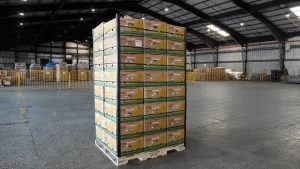How Can We Efficiently Manage the Return of Grocery Items Packed in Banana Boxes?
What Challenges Arise in Handling Returned Banana Boxes?
In a bustling grocery chain on the east coast, the task of managing merchandise slated for return presents a unique challenge. Each store is responsible for the collection of such items, ranging from canned goods and bottles to cartons and packages. These items could be out-of-date, damaged, or part of a product recall. To facilitate their return to the central hub, these goods are packed into banana boxes.
Once at the central distribution center, the goods arrive palletized in banana boxes, stacked meticulously at four layers high, with each layer supporting six boxes, amounting to 24 boxes per pallet. Each box can weigh up to 40 lbs. The employees are tasked with manually unloading these boxes and sorting their contents on a designated platform. Here, items are divided into three categories: those to be returned to suppliers, those to be donated to local charities, and those to be recycled or discarded.
This routine amounts to an arduous manual handling operation. Workers might manage numerous boxes daily, effectively lifting thousands of pounds per shift, which inevitably involves considerable bending, stretching, and other postural stresses.
How Does Ergonomic Equipment Solve the Challenge?
To combat the risk associated with manual handling and to enhance employee comfort, the grocery chain's management decided to invest in ergonomic solutions. Their strategic investment included a hydraulic lift table—a robust piece of equipment with a 40" x 48" platform capable of supporting up to 2,000 pounds. This lift allows for vertical positioning of the boxes, enabling employees to access them comfortably without the strain of extensive bending or stretching.

In practical terms, an entire pallet is placed onto the lift. As items are sorted from the top layer of boxes, the lift is adjusted to raise the subsequent layer, maintaining optimal height for ease of access. This smart and ergonomic application makes a significant difference in handling efficiency.
Moreover, the lift features a turntable platform, enabling workers to rotate pallets seamlessly. This innovation allows easy reach to every box from one side, negating the need to stretch or maneuver around the pallet, therefore streamlining the process even further.
The incorporation of this versatile equipment has revolutionized workplace safety and productivity, making the daunting task of handling returned banana boxes more manageable and stress-free.
What Insights Can We Draw for Similar Projects?
Implementations akin to this project highlight the pivotal role ergonomic solutions play in material handling. Various industries grappling with manual handling challenges can draw inspiration from this case. The ergonomic approach doesn't just enhance comfort; it boosts efficiency and reduces injury risks.
Considering other similar projects, investing in adjustable height solutions, such as lift tables in warehouses or manufacturing plants, can yield significant benefits. Incorporating turntable platforms in congested work environments can further optimize workflow and minimize physical strain on workers. Ultimately, such investments not only advocate for worker welfare but also enhance operational proficiency, paving the way for safer and more productive environments in sectors facing similar challenges.
Embedding ergonomics into the DNA of industry operations is no longer a luxury but a necessity that future-proofs businesses against inefficiencies and workforce dissatisfaction.



